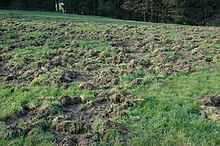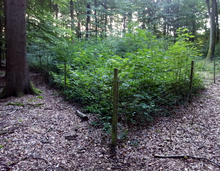Game damage
As Wildschaden be Wild caused damage in particular to those in the agriculture , forestry and fisheries .
The damage that occurs when a vehicle collides with a wild animal is not considered to be damage to wildlife in the legal sense, but is referred to as an accident with wildlife . The resulting damage to the vehicle is accidental damage, which is usually covered by the partial vehicle insurance. Likewise, damage caused by game is not to be confused with damage caused by hunting that can occur while hunting .
Game damage in agriculture

In terms of German hunting laws , game damage in agriculture is damage to the land used, its seeds and crops by hoofed game , wild rabbits and pheasants .
The agricultural game damage is caused by wild boars ( wild boars ) that visit the fields during sowing and feed on the seeds, e.g. B. seed potatoes, seed cereals such as wheat and corn. Of particular concern is the damage that wild boars cause to ripe crops, particularly potatoes, wheat, oats and maize. Even deer caused major damage by wild animals here.
The meadow damage caused by wild boars is also of great importance. So, especially in spring, they go to the meadows and pastures and look for grubs and mice there for the purpose of protein intake. To do this, they rummage over the surfaces (one speaks of breaking in a hunted manner ) and thus cause great damage.
Even in the early Middle Ages under Carolingian rule, there were complaints about high damage caused by game. The desire of the nobility for a lot of game for representative hunting was always in conflict with the fear of the rural population for their harvest. In the peasant wars , important demands were those for free hunting.
Game damage in forestry

Game damage in forestry refers to damage to the flora through browsing, peeling and rubbing ( sweeping ) game against forest plants .
Unlike on agricultural land, game browsing in the forest can also cause long-term ecological damage. In particular, with roe deer as the selector with the selective browsing of the buds, species-rich mixed forests can in the long term become a species-poor pure stand by completely gnawing out the tree species that are more palatable to the game .
Examples are the typical mixed mountain forest in the Alps made up of spruce, silver fir, beech, sycamore maple, sycamore elm, ash, whitebeam, rowanberry and yew tree. Although all these tree species still shed sufficient seeds and these also germinate, in some places only the insensitive spruce (and beech) survive the feeding pressure of deer , deer and chamois .
Even in the Spessart , which has been known for centuries for its imposing mixed stands of oak and beech , game browsing leads in some places to the total loss of oak seedlings and thus to pure beech stands. Elsewhere, the regeneration of potentially autochthonous hardwood stands on historically old forest locations is being destroyed, which poses a threat to their genetic information.
Compared to agricultural game damage, forestry game damage is less obvious every year - but all the more significant in terms of its long-term consequences. Up to the loss of autochthonous, genetic information from tree species.
The same deadlines for registration apply for the game damage regulation as for agriculture. In almost all German federal states , the damage caused by game in the forest is assessed by the forest authorities in vegetation reports.
Liability for game damage
The law on compensation for game damage is currently standardized in §§ 29 ff. Of the Federal Hunting Act (BJagdG). According to this, the hunting association has to compensate for the damage caused by hoofed game , wild rabbits or pheasants to a property that belongs to a community hunting district or is affiliated to a community hunting district . The hunting tenant who has leased the hunt in question is usually obliged in the hunting lease agreement to partially or fully compensate for the damage caused by game. Today, hunting leases increasingly include a lump sum for game damage. There are also lease contracts that contain a so-called peak billing of the actual game damage prevention measures. Newer contract models sometimes very specifically define the amounts of money to be reimbursed for each damaged plant or area. In the event of disagreements between the parties, an expert opinion can be obtained from a sworn expert (a game damage appraiser appointed by the Lower Hunting Authority ). In the event that the injured party cannot obtain compensation from the lessee, the hunting association's obligation to pay compensation remains in place ( subsidiarity of liability). In addition, the injured party has an obligation to cooperate in the prevention of game damage according to BJagdG §§ 32 and 34. In the future, it will increasingly be about prevention, not replacement of game damage.
literature
- Hans Drees (founder), Hans-Jürgen Thies: Game and hunting damage. Instructions for the assertion and determination of game and hunting damage . 8th, revised edition. Deutscher Gemeindeverlag and Kohlhammer, Stuttgart 2006, 188 (XII) S., ISBN 978-3-555-01388-6 or ISBN 3-555-01388-2
- Rolf Bergheim et al .: Game damage in fields and forests. Recognize, prevent, regulate . Deutsche Jagd-Zeitung Spezial No. 4. Parey, Singhofen 2000, 97 pp. ISBN 3-89715-303-3
- Martin Moog: Evaluation of game damage in the forest. Models - Methods - Evaluation . Neumann-Neudamm, Melsungen 2008, 220 pp., ISBN 978-3-7888-1189-1
- Bruno Hespeler : Game damage today. Prevention, detection, defense . BLV, Munich, Vienna and Zurich 1999, 223 pages, ISBN 3-405-15423-5
- Mario Genth, Wildlife Damage Compensation - In the Change of Time, in: Contributions to hunting and wildlife research , Volume 32 (2007), pp. 517-523.
- Wolfgang Schwenke (ed.), Walter Bäumler, Max Postner, Erhard Ueckermann : The forest pests of Europe. A manual in five volumes - Volume 5: Vertebrates . Paul Parey, Hamburg and Berlin 1986, ISBN 3-490-11516-3
- Erhard Ueckermann : Game damage prevention. The prevention of game damage in forests and fields. a practical guide to technical protective measures . Series of publications by the Research Center for Hunting and Game Damage Prevention of the State of North Rhine-Westphalia, Issue 2. 4., revised and expanded edition. Parey, Hamburg and Berlin 1981, 80 pages, ISBN 3-490-18912-4
- Holger Konrad, Game Damage Compensation in Community Hunting Districts According to Section 29 Paragraph 1 BJagdG - History, Systematics and Current Issues , Series: Studies on International, European and German Sustainability Law, Vol. 3, 1st edition, LIT Verlag Münster 2012, plus: Trier, Univ., Diss., 2012, ISBN 978-3-643-11614-7
- Federal Hunting Act as published on September 29, 1976 ( Federal Law Gazette I p. 2849 ), which was last amended by Article 1 of the law of May 29, 2013 ( Federal Law Gazette I p. 1386 )
- Ilse Haseder , Gerhard Stinglwagner : Knaurs Großes Jagdlexikon , Augsburg 2000, keyword: Wildschaden, ISBN 3-8289-1579-5
- Christian Ammer , Torsten Vor, Thomas Knoke , Stefan Wagner: The forest-wild conflict. Analysis and solution approaches against the background of legal, ecological and economic relationships. Göttingen Forest Sciences - Volume 5, Göttingen University Press: Göttingen 2010, ISBN 978-3-941875-84-5 , online; PDF; 4.51 MB
Web links
- Text of the Federal Hunting Act with the principles of game damage prevention and game damage compensation
- waldwissen.net : Assessment of game browsing in natural regeneration
Individual evidence
- ↑ BJagdG §§ 29ff
- ↑ Federal Hunting Act
- ↑ BJagdG §29: (1) If a property that belongs to a community hunting district or is attached to a community hunting district (Section 5, Paragraph 1) is damaged by hoofed game, wild rabbits or pheasants, the hunting association has to compensate the injured party for the damage caused by game . The compensation paid out of the cooperative's treasury is to be borne by the individual hunting companions in proportion to the area of their participating properties. If the hunting tenant has taken over the replacement of the game damage in whole or in part, the obligation to compensate lies with the hunting tenant. The hunting association's obligation to pay compensation remains as long as the injured party cannot obtain compensation from the lessee
- ↑ BJagdG § 35 Proceedings in matters related to game and hunting damage: In matters related to game and hunting damage, the federal states can make the use of the ordinary legal process dependent on a prior determination procedure before an administrative authority (preliminary proceedings) in which an enforceable declaration of commitment (acknowledgment , Settlement) or an enforceable decision (preliminary ruling) is to be issued after it becomes final. The Länder make the more detailed provisions on this
- ↑ BJagdG § 32 Protective devices (1) There is no entitlement to compensation for game damage if the injured party invalidates the measures taken by the person authorized to hunt to prevent game damage.
- ↑ BJagdG § 34 assertion of damage: The right to compensation for game or hunting damage expires if the person entitled does not report the damage within one week after he has become aware of the damage or had received due care when observing the damaged Property responsible authority. In the case of damage to land used for forestry purposes, it is sufficient if it is reported to the responsible authority twice a year, by May 1st or October 1st. The registration should identify the person claimed to be liable for compensation.



